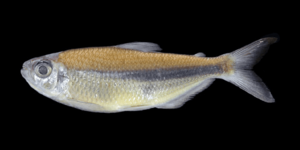Bryconops colaroja facts for kids
Quick facts for kids Bryconops colaroja |
|
|---|---|
 |
|
| Preserved specimen | |
| Conservation status | |
| Scientific classification |
Bryconops colaroja is a small, unique fish. It lives only in the small rivers and streams of the Cuyuni River basin in Venezuela. Its name, "colaroja," means "red tailed" in Spanish. This is because its tail fin is a bright, deep red. This special color makes it stand out from most other fish in its family.
Contents
Meet the Red-Tailed Fish!
The Bryconops colaroja is one of the smaller fish in its group. It usually grows to about 7.8 centimeters (about 3 inches) long. Its body shape is similar to a minnow or a smelt.
What Does It Look Like?
This fish has mostly greenish-silver scales. Its back is a bit darker than the rest of its body. Unlike some other fish, it doesn't have any big spots or markings on its scales. This smooth color helps scientists tell it apart from other fish in the Bryconops family. For example, B. colanegra has dark spots near its cheeks and eyes.
Its Special Red Tail
The Bryconops colaroja is famous for its bright red tail fin. It's the only fish in its group with a completely red tail. Only one other fish, Bryconops imitator, looks very similar. The red color is why it's called "colaroja," which means "red tail." Sometimes people call it the redtailed bryconops, but this name is not widely used.
How Scientists Classify It
Scientists use a system called Taxonomy to group living things. This helps them understand how different species are related.
Its Scientific Name
Bryconops colaroja was first described in 1999. Its full scientific name is Bryconops (Creatochanes) colaroja. It doesn't have many other names, and it's usually easy to identify because of its red tail.
Its Fish Family
For a long time, Bryconops colaroja and all other Bryconops fish were part of the Characidae family. But in 2011, new research changed things. Scientists moved Bryconops and two other groups of fish to a new family called Iguanodectidae. This is where B. colaroja belongs today.
Where It Lives and What It Does
Bryconops colaroja is found only in the Cuyuní river basin. This area is near the border between Venezuela and Guyana. However, you won't find it in the main Cuyuni River. It prefers smaller creeks and streams.
Its Home Environment
This fish likes water that is a little bit acidic. It also prefers areas with a rocky or sandy bottom. The waters where it lives are often "blackwater" rivers. These rivers get their dark color from natural substances in the water. Blackwater rivers don't have a lot of oxygen. This means B. colaroja is good at living in places with less oxygen.
What It Eats
Scientists haven't studied the diet of Bryconops colaroja in great detail. But we know a lot about what other fish in its group eat. Most of them are insectivores, meaning they mostly eat insects. They like different kinds of bugs.
For example, the orangefin tetra (B. affinis) eats plants too, but still loves insects. The tailspot tetra (B. caudomaculatus) can even jump out of the water to catch flying insects! Based on this, scientists believe B. colaroja mainly eats insects, but might also munch on some plants.
Protecting the Red-Tailed Fish
The IUCN says that B. colaroja is a species of "Least Concern." This means it's not currently in danger of disappearing.
Challenges It Faces
Even though it's not endangered, there are some worries. The main Cuyuni River is often affected by mining activities. This can disturb the water and damage the riverbanks. The Cuyuni River is not always in good health. This puts B. colaroja and other native fish at risk.
However, miners have noticed this fish in the past. This has made them more willing to take steps to protect it.


